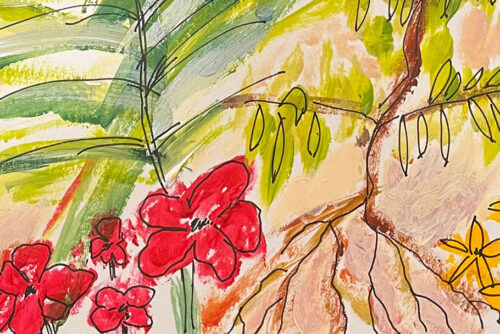The Formation of BOSS and Protests at Barnard
The Barnard Organization of Soul Sisters (BOSS), founded in the fall of 1968, was an outgrowth of alienation and black nationalism, re-enforced by the new spirit of protest produced by spring 1968 protests.
The formation of BOSS and the protest movement at Barnard can be best understood in terms of Doug McAdam’s model for the development of social movements laid out in his book Political Process and the Development of Black Insurgency, 1930–1970. 1 Doug McAdam argues that there are four elements necessary for the formation of a social movement: changes in broad socioeconomic processes, expansion of political opportunities, cognitive liberation, and the mobilization of indigenous organizational strength of a community. 2 According to McAdam, broad socioeconomic changes are “any event or broad social process that serves to undermine the calculations and assumptions on which the political establishment is structured.” Broad socioeconomic changes occasion changes in political opportunity. McAdam explains that political opportunity is the test of a political system’s vulnerability to assaults by excluded groups. Cognitive liberation is the idea that “[b]efore collective protest can get underway, people must collectively define their situations as unjust and subject to change through group action.” Indigenous organizational strength is the ability to turn indigenous community groups to the purposes of the social movement. 3 The protests at Barnard, in many ways a microcosm of social movements, fit within McAdam’s structure.
The broad socioeconomic change that engendered more political opportunity was the recruitment of black students to Barnard. The increased population of black students created a critical mass of students, so that unlike previous generations they had a significant presence and voice on campus. Black Barnard students achieved cognitive liberation through their witnessing of and participation in Columbia student protests. These protests, and of course the numerous other protests going on throughout the country, heightened awareness on Barnard’s campus about the possibilities for change via protest. Finally, the most critical aspect of the Barnard movement came with the formation of BOSS, which provided black Barnard students the indigenous organizational strength necessary for a social movement. It was the formation of BOSS and its subsequent conversion into a protest organization that immediately precipitated the protests at Barnard.
As black students began to form a community on campus and a salient identity, they began an organization that would help them meet their needs; as such they would also have a formal forum for airing of grievances and planning action to deal with those grievances. As Frances Sadler recalled, “Well, we didn’t think BOSS was starting something. It was the black women who were in one place at one time sitting down, talking about stuff . . . stuff that was affecting us. And so we met a few times, we talked a few times. We sort of fueled each other’s feelings of isolation and the University’s responsibility to us.” 4
According to the Barnard Alumnae Magazine, the college first became aware that black students were organizing in October 1968, when signs were seen around campus calling for meetings for all black students. 5 At its inception, BOSS could be defined as the name given to Barnard’s black community because as one member stated to the Barnard Alumnae Magazine in 1969, “If you’re black you’re automatically a member—everyone belongs although there’s no formal membership.” 6 At first, black Barnard women attended meetings of the Student Afro-American Society (SAS) looking for community; however, it soon became clear that that particular organization would not meet their needs. Frances Sadler remembered, “Well, the Student Afro-American Society was a University wide organization . . . a Columbia-issues-dominated organization and a male-dominated organization. And we were sort of not into deferring, and also not into sit-ins, or not as strongly interested in Columbia issues . . . . And we had our own problems, own issues.” 7 As a result of this disillusionment with SAS, BOSS was formed.
When BOSS was initially formed, it was a very informal organization that did not receive funding from Barnard’s student activities budget. 8 In fact, Francis Sadler, one of the founders, did not think she was aware at the time that Barnard offered student groups an activities budget. The group did not initially plan many formal events. It was more of a support group. As Karen Butler noted, “[W]e were just there kind of support with homework, just being together. All together, in an environment that a lot of us had never really been in, predominantly a white environment. Some people had come from prep schools but a lot of us hadn’t; it was just a sense of family, that’s what we kind of tried to fulfill.” 9 However, although not all the black students at Barnard were active participants of BOSS, BOSS soon became the voice of black students on campus, a vehicle through which to protest and make demands on the college, and a forum for presenting new ideas about integration to the college community.
According to the Barnard Alumnae Magazine, by January 1969 BOSS had elected a steering committee consisting of Carmen Martinez, Alma Kinney, and Clara Hayley, and it had issued a manifesto. 10 Having come together, realizing that they shared many of the same complaints, and forming a black students’ organization, they began demanding that Barnard become more responsive to their needs.
- Doug McAdam, Political Process and the Development of Black Insurgency, 1930–1970 (Chicago: The University of Chicago Press, 1982).[↑]
- Ibid., 51.[↑]
- Ibid., 41–51.[↑]
- Sadler, interview.[↑]
- Andrée L. Abecassis, “Blacks at Barnard: A Survey of Policy and Events,” Barnard College Alumnae Magazine, Spring 1969, 4.[↑]
- Ibid.[↑]
- Sadler, interview.[↑]
- Ibid.[↑]
- Butler, interview.[↑]
- Abecassis, “Blacks at Barnard,” 5.[↑]



